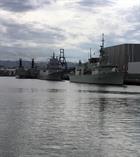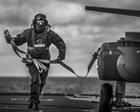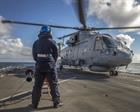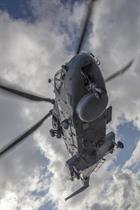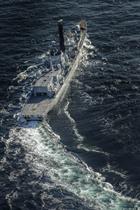ROYAL NAVY JOINS MAJOR NATO SUB-HUNT EXERCISE IN ICELAND
Royal Navy warships, helicopters and a submarine today begin a 14-day battle in Icelandic waters. More than 500 British submariners, sailors and aviators are locking horns for NATO’s annual test of anti-submarine forces in cooler climes.
Exercise Dynamic Mongoose, which begins today in Reykjavik, involves around a dozen warships and submarines – nuclear, such as Royal Navy hunter-killer HMS Trenchant, and diesel-powered – and around 2,000 military personnel drawn from Canada, France, Germany, Norway, the UK and US.
Leading the charge above the waves are Portsmouth-based frigates HMS Kent and Westminster, each dedicated submarine hunters, and each with a specialist submarine-hunting Merlin Mk2 helicopter embarked.
A 14-strong team of aviators and engineers from 814 Naval Air Squadron from Culdrose in Cornwall provides the helicopter for both ships.
Kent takes part in Dynamic Mongoose having spent the spring focusing on tracking submarines in the Arctic, Baltic and just last week working with carrier HMS Queen Elizabeth in home waters.
“The exercise sees the combined team of HMS Kent and her Merlin pitted against other nations’ submarines playing ‘the enemy’, a complex game of cat and mouse which everyone prides themselves in winning,” said Lieutenant Commander Sid Shaw, in charge of Mohawk Flight on Kent.
“Preparation involves every member of the Flight. The team are experienced operating from a small flight deck and hangar. It’s a harsh environment but one Mohawk Flight pride themselves in operating safely in.”
The engineers contended with choppy seas of four to five metres to prepare the Merlins as the frigates crossed the North Atlantic.
Each helicopter is expected to be flying for up to eight hours a day – operating in a harsh environment and using sensitive, hi-tech equipment including a ‘dipping’ sonar, lowered from the Merlin, or a sonobuoy, dropped in the ocean to listen for the presence of submarines.
“It’s great to see a different side of the Navy compared to the day-to-day living on an air station,” said Air Engineering Technician Alex Thomas on HMS Kent.
“Integrating with the ship’s company and learning what they do has changed my outlook on working and living at sea.”
As well as submarine-hunting helicopters such as Kent and Westminster’s Merlins, assisting the hunt in Atlantic skies are long-range maritime patrol aircraft, including, for the first time, one of the RAF’s new P8 Poseidons.
Dynamic Mongoose is the second of NATO’s two annual anti-submarine workouts, following Dynamic Manta (‘Dynamic’ denotes an exercise, words beginning with ‘M’ that it’s maritime) off Sicily back in February.
Manta tests the ability of submarine hunters in warmer seas, Mongoose – which alternates between Norway and Iceland every other year – focuses on the hunt in the cooler waters of the Atlantic as temperature plays a key role in the effectiveness of sonar; the sea off Iceland is five degrees cooler than the Mediterranean around Sicily back in February.
“Dynamic Mongoose remains one of the most challenging exercises and an excellent opportunity for NATO nations’ naval forces to practise and evaluate their anti-surface and anti-submarine warfare skillsets in the challenging environment of the North Atlantic,” said Rear Admiral Andrew Burcher, Commander NATO Submarines.
“This exercise is a unique opportunity to enhance naval forces’ war fighting skills in all dimensions of anti-surface and anti-submarine warfare in a multinational and multi-threat environment.”


